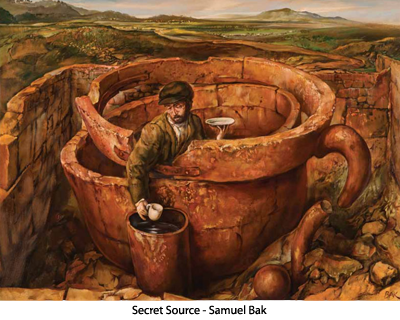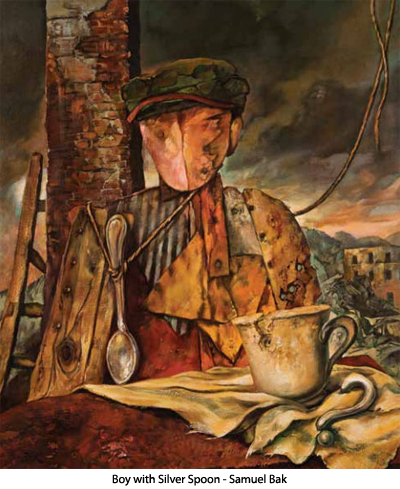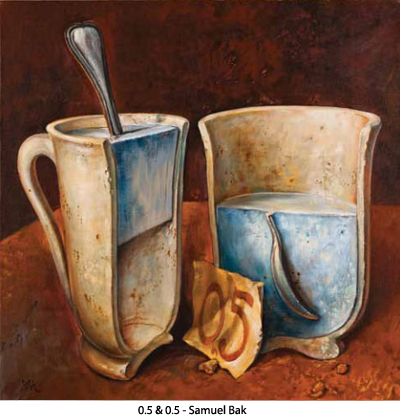May 29, 2014
by Samantha Burgoon
 In a 2008 interview, Samuel Bak explained his connection to the maxim: a miserable childhood is a writer’s goldmine (1). That statement certainly holds true for the painter and Holocaust survivor, who, by the end of World War II, had experienced countless atrocities, and who, aside from his mother, was the only surviving member of his once-large family.
In a 2008 interview, Samuel Bak explained his connection to the maxim: a miserable childhood is a writer’s goldmine (1). That statement certainly holds true for the painter and Holocaust survivor, who, by the end of World War II, had experienced countless atrocities, and who, aside from his mother, was the only surviving member of his once-large family.
At the age of 80, Bak continues to cull inspiration from his tumultuous upbringing. The works that have sprung forth from his reflections are fraught with grief and a search for understanding—themes which are seen throughout the artist’s deeply allegorical landscapes and still-lives.
Bak’s work is laden with symbolism, and in his current exhibition at Pucker Gallery, one of his most prominently used motifs—the cup—takes center stage. The image of a teacup appears in every one of the over forty oil paintings, watercolors, and sketches in this exhibition—some are delicately held, others are large enough to contain entire landscapes. Some are stacked precariously atop one another, others lay overturned, discarded, and crumbling. None are pristine, none are intact.
Perhaps Bak has found a new application for the traditional use of cups: They are tools of consumption, they help us imbibe. We use them to portion out manageable amounts, and then employ them as aids in taking those quantities into ourselves. Bak’s cups are filled with, or surrounded by, dreamlike, desolate landscapes, which feel as if they have been painted from memory. Perhaps the artist hopes that by containing fragments and recollections of his past in these teacups, his unpacking of his experiences will prove more manageable.
Such is the assumption with a painting like Secret Source, in which a middle-aged man (ostensibly, a self-portrait) sits within a large teacup-shaped structure, engaged in the act of filling his appropriately-sized teacup with liquid from an adjacent well. This central image is positioned within a landscape that feels both familiar and vague: It is made up of what appears to be a stretch of sprawling, overgrown farmland; land which seems to have not been tended to in years. A dilapidated stone wall beside the man in the teacup is the only evidence of past human habitation. The protagonist of the painting is placidly existing in a landscape of memories, seemingly unbothered by the strangeness of his situation, and is literally drinking it in.
 This scene occurs again in the piece Countless Mornings; however, the landscape in this piece is more active and threatening. The drinking man sits perilously perched on the lip of a massive cup, which appears to have sprouted from the savage landscape itself. Fault lines appear on the ancient-looking ground and several more gargantuan cups lie in the background, filled with earth, succumbing to decay. The clever title calls to mind the common routine of morning tea, and yet the imagery of the painting suggests something far more dangerous. Knowing what we do about Bak's past, perhaps the ritual to which the title refers is the artist’s frequent and deliberate investigations into himself and his experiences.
This scene occurs again in the piece Countless Mornings; however, the landscape in this piece is more active and threatening. The drinking man sits perilously perched on the lip of a massive cup, which appears to have sprouted from the savage landscape itself. Fault lines appear on the ancient-looking ground and several more gargantuan cups lie in the background, filled with earth, succumbing to decay. The clever title calls to mind the common routine of morning tea, and yet the imagery of the painting suggests something far more dangerous. Knowing what we do about Bak's past, perhaps the ritual to which the title refers is the artist’s frequent and deliberate investigations into himself and his experiences.
In Countless Mornings, as well as in several other paintings included in the exhibition, we see another of Bak’s frequently used symbols: the question mark. These punctuations appear abstractly, formed by teacup handles, debris, or as earthen forms made from the landscapes themselves. These marks serve as reinforcements of the artist’s yearning and inability to fully make sense of his world.
In the piece Boy with Silver Spoon, a question mark, made up of amorphous white shapes, lies in front of a filthy, chipped teacup. Behind this still-life is the form of a boy who is not actually a boy, but who is rather a faceless creation tacked together from wood and refuse. With no arms of his own, the boy’s titular silver spoon is tied to his neck with rope. It is a haunting image that blurs the line between portraiture and still-life. Behind the boy a lies a dilapidated city, which has been mostly razed to the ground. Bak has stated that ”the most important thing an artist can tell is the truth about himself”—viewing pieces such as this one, it is difficult not to mourn the artist’s childhood.
Although feelings of grief and heartbreak are evident in Bak’s work, he is not self-pitying. Throughout the works, certain pieces reveal a sense of optimism in the future; if there is a spirit residing in Bak’s work, it is one that has not given up, and who has not lost hope. The artist’s willingness to engage with the possibility of interpreting his experiences in a positive way is laid out matter-of-factly in his piece 0.5 & 0.5. Bak is an artist who very much appreciates word-play, and in this painting, he takes a literal approach to the depiction of the question, is a glass half full or half empty? These moments of humor, though still tinged with a solemn understanding of what man is capable of, keep Bak’s work from becoming bogged down by their images of gloom and loss.
 Similarly, the several watercolors and sketches included in Pucker Gallery’s exhibition reveal a lighter side of the artist’s work. In the drawing On Love, Etc., two question-mark forms hang behind a cup and meet in a ”kiss,” consequently forming the shape of a heart. This still life is painted as a picture-within-a-picture; its drawn paper tacked to an imaginary wall, creating a Trompe-l'œil effect. The piece feels dreamy and surreal, and seems to posit questions about the nature of reality and perception.
Similarly, the several watercolors and sketches included in Pucker Gallery’s exhibition reveal a lighter side of the artist’s work. In the drawing On Love, Etc., two question-mark forms hang behind a cup and meet in a ”kiss,” consequently forming the shape of a heart. This still life is painted as a picture-within-a-picture; its drawn paper tacked to an imaginary wall, creating a Trompe-l'œil effect. The piece feels dreamy and surreal, and seems to posit questions about the nature of reality and perception.
As a whole, the works in the exhibition form a sweeping look into the memories and contemplations of their artist. Although desolation and loss color many of the pieces, Bak’s wit, and his nods to surrealism imbue the works with a forward-thrust. Bak’s imagined landscapes and impossible still-lives form the reflections of a man who has seen his world shattered into pieces, but who believes in the merit of trying to put it all back together.
(1) The interview I reference can be found here: https://www.youtube.com/watch?v=iAdYfWGGSSo
Transcending Passages, Maisoon Al Saleh, March 16th - April 6th, 2021
Unbound Perspectives - SEPTEMBER 26-OCTOBER 17, 2020
East Villager Billy The Artist Climbs Atop Ai Wei Wei's Fence To Shine A Light On It
A Quick Note on Transplants: Greek Diaspora Artists
Teddy Thompson’s Ultimate Funeral Mix Tape
Moray Hillary, Pre-New Reflective by Heather Zises
SELFISH, Review by Heather Zises
Winter Realm Series by Noah Becker
Paul Rousso at Lanoue Fine Art
Airan Kang, The Luminous Poem at Bryce Wolkowitz Gallery
Damien Hoar De Galvan at Carroll and Sons
Antigone, 2015, directed by Ivo van Hove
Karen Jerzyk's unsettling Parallel World
CEK - Concrete Functional Sculptures
Alexis Dahan, ALARM! At Two Rams
Do Ho Suh, Drawings, at Lehmann Maupin
Nir Hod, Once Everything Was Much Better Even the Future
Exhibition Review: Mario Schifano 1960 – 67
Subverting the Realist Impulse in the Work of Shauna Born
Linder: Femme/Objet by Erik Martiny
What We Do in the Shadows by Jemaine Clement and Taika Waititi
Justin Kimball at Carroll and Sons
Accumulation: Sculptural work by Alben at Gallery Nines
Collective Memory Manipulated: Sara Cwynar’s Flat Death
Art Paris Art Fair 2013 Review
Paris Street Art Musée de la Poste
Trellises by Katherine Tzu-Lan Mann
Topography of Destruction Kemper Museum
L'art en Guerre : France 1938-1947
The Louvre Relocates to Africa
A French Priest, Tears and Fire the Art of Jean-Michel Othoniel
